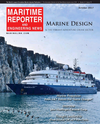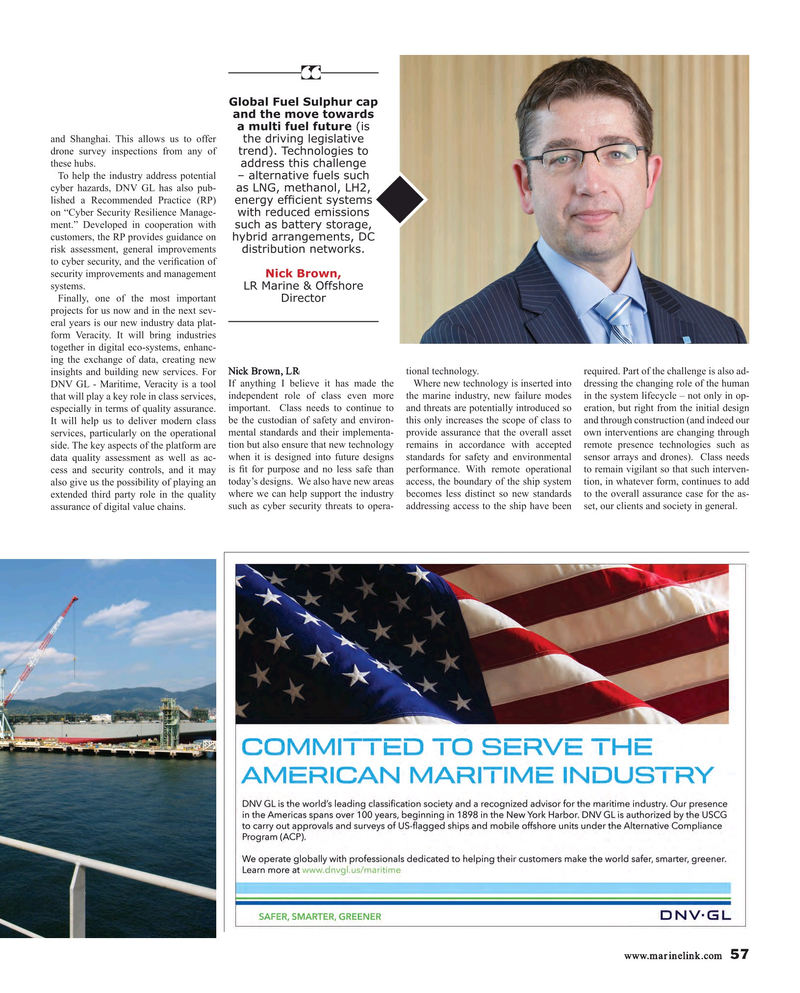
Page 57: of Maritime Reporter Magazine (October 2017)
The Marine Design Annual
Read this page in Pdf, Flash or Html5 edition of October 2017 Maritime Reporter Magazine
“
Global Fuel Sulphur cap and the move towards a multi fuel future (is and Shanghai. This allows us to offer the driving legislative drone survey inspections from any of trend). Technologies to these hubs. address this challenge
To help the industry address potential – alternative fuels such cyber hazards, DNV GL has also pub- as LNG, methanol, LH2, lished a Recommended Practice (RP) energy ef? cient systems on “Cyber Security Resilience Manage- with reduced emissions ment.” Developed in cooperation with such as battery storage, customers, the RP provides guidance on hybrid arrangements, DC risk assessment, general improvements distribution networks.
to cyber security, and the veri? cation of security improvements and management
Nick Brown, systems.
LR Marine & Offshore
Finally, one of the most important
Director projects for us now and in the next sev- eral years is our new industry data plat- form Veracity. It will bring industries together in digital eco-systems, enhanc- ing the exchange of data, creating new insights and building new services. For Nick Brown, LR tional technology. required. Part of the challenge is also ad-
DNV GL - Maritime, Veracity is a tool If anything I believe it has made the Where new technology is inserted into dressing the changing role of the human that will play a key role in class services, independent role of class even more the marine industry, new failure modes in the system lifecycle – not only in op- especially in terms of quality assurance. important. Class needs to continue to and threats are potentially introduced so eration, but right from the initial design
It will help us to deliver modern class be the custodian of safety and environ- this only increases the scope of class to and through construction (and indeed our services, particularly on the operational mental standards and their implementa- provide assurance that the overall asset own interventions are changing through side. The key aspects of the platform are tion but also ensure that new technology remains in accordance with accepted remote presence technologies such as data quality assessment as well as ac- when it is designed into future designs standards for safety and environmental sensor arrays and drones). Class needs cess and security controls, and it may is ? t for purpose and no less safe than performance. With remote operational to remain vigilant so that such interven- also give us the possibility of playing an today’s designs. We also have new areas access, the boundary of the ship system tion, in whatever form, continues to add extended third party role in the quality where we can help support the industry becomes less distinct so new standards to the overall assurance case for the as- assurance of digital value chains. such as cyber security threats to opera- addressing access to the ship have been set, our clients and society in general.
www.marinelink.com 57
MR #10 (50-57).indd 57 MR #10 (50-57).indd 57 10/5/2017 9:57:53 AM10/5/2017 9:57:53 AM

 56
56

 58
58
